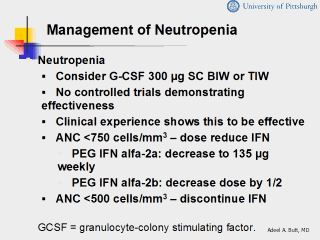| front |1 |2 |3 |4 |5 |6 |7 |8 |9 |10 |11 |12 |13 |14 |15 |16 |17 |18 |19 |20 |21 |22 |23 |24 |25 |26 |27 |28 |29 |30 |review |
 |
Key Point
Treatment with G-CSF in patients with neutropenia may be useful to reduce
symptoms and maintain effective dose of therapy as well as patient adherence
to therapy. Neutropenia is a relatively common occurrence in HCV-infected patients who are receiving PEG IFN alfa-2a plus RBV. In the past, the primary management of neutropenia was dose reduction, after which neutrophil counts quickly improve. The more recent findings of the importance of adherence to therapy have led to the consideration of the use of G-CSF to maintain the absolute neutrophil count (ANC) above 750, thus obviating the need for dose reduction. No studies have demonstrated that supportive therapy with G-CSF will result in dose maintenance and SVR. Current recommendations include dose reduction of IFN when ANC declines to less than 750. Because neutropenia increases the risk for infection, it is important that all HCV-infected patients are vaccinated annually against the flu and practice good health habits, such as hand washing, etc. References National Institutes of Health Consensus Development Conference Statement. Management of hepatitis C: 2002. Bethesda, Md: National Institutes of Health; June 10-12, 2002. Fried MW. Side effects of therapy and management. National Institutes of Health Consensus Development Conference Statement. Management of hepatitis C: 2002. Bethesda, Md: National Institutes of Health; June 10-12, 2002. Abstract. PEGASYS® Complete Product Information. Nutley, NJ: Hoffman-La Roche Inc; 2002. |